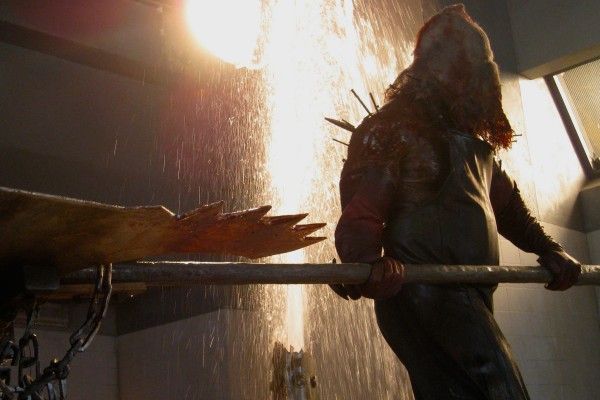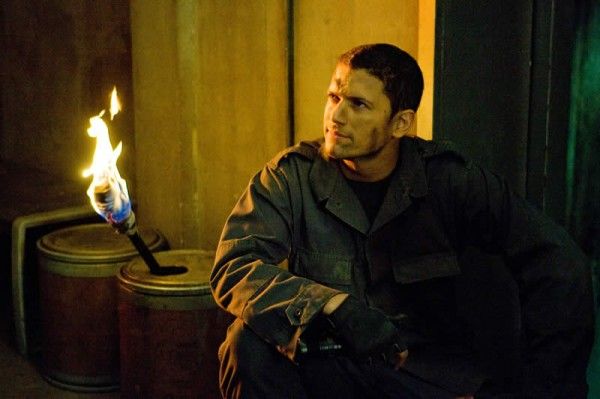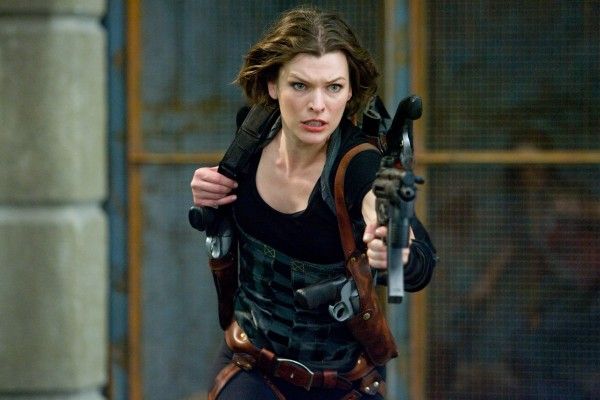In Resident Evil: Afterlife, opening in theaters on September 10th, Alice (Milla Jovovich) continues on her journey to find survivors of the virus infection and lead them to safety. A new lead that promises a safe haven from the Undead takes them to Los Angeles, but when they arrive the city is overrun and they must fight for their lives.
While at Comic-Con, writer/director Paul W.S. Anderson spoke at a roundtable about adding new characters, making the action bigger and shooting in 3D. He also gave an update on how his version of The Three Musketeers is coming along. Check out what he had to say after the jump.
As these films get bigger, is it important that the action also gets bigger in scope?
PAUL W.S. ANDERSON: Whereas the first movie was like a chamber piece of horror, as the games evolved, they folded in bigger and bigger action. That’s the direction the game franchise went in, and so have the movies. As the action gets bigger, obviously the munitions get bigger as well.
What were the biggest challenges in filming this in 3D?
ANDERSON: If you work with any new technology, you have to expect that it’s going to be a little problematic. Certainly, the cameras were a little twitchy, and you’d get less footage and less set-ups every day. The interesting thing about it was that you just composed images in a completely different way because we had big 3D monitors on set, and you’d wear the glasses and see the image in 3D.
What specific things did you do differently, filming in 3D?
ANDERSON: I moved the camera in a completely different way than I had done on the movie I did beforehand. Death Race was a very modern action movie and it used all of those modern action techniques with lots of hand-held camera, lots of punchy zooms, and lots of quick movements and quick cuts. In 3D, I didn’t want to do that anymore. I went for a more classical approach to filmmaking with lots of dolly, track and cranes, and slightly slower, more choreographed fight moves, so you get more fight moves in one take. It just looked better in 3D and it allowed you to experience the space a little more. It really altered the way I shot the movie completely, and it was exciting because, after 20 years of filmmaking, I felt like I was making my first movie, all over again. That’s what makes a mockery of a lot of these 3D conversions, where they’re shot in 2D and converted to 3D. Having laid a real 3D movie, you realize that it’s right in the production design. You design sets that enhance the 3D and you design interactive elements, like the rain or smoke. If you’re shooting 2D, you don’t know about that.
Are you going to continue working in 3D?
ANDERSON: 3D is very exciting. I love it. I’m a complete convert. Everything for me, from now on, is 3D. I’m completely convinced it’s the future of home entertainment, as well as cinema entertainment. I think it’s a paradigm shift, in terms of cinema, and those things don’t happen very often. The introduction of sound, the introduction of color photography and now 3D have been the big shifts. They happen once every 40 or 50 years, so it’s very exciting to be a filmmaker, working while one of them is happening. Also, we’re really on the cutting edge. When we wrapped Resident Evil in December of last year, we were a 3D movie, but it was no big deal. And then, Avatar came out and the whole of Hollywood was like, “Look at these grosses! 3D is huge. Let’s all be 3D!” We just got on with doing what we were doing, which was making what we think is a really quality, kick-ass 3D movie, and we’ll really be the first live-action 3D movie of the year. There hasn’t been one this year yet. It’s all been conversions. When people see what real 3D looks like, they’ll go, “Oh, that’s why I spend an extra $5 a cinema ticket. That’s worth it!”
Are there going to be a lot of digital effects being thrown with the 3D?
ANDERSON: What happened with Final Destination was that the movie was in post-production for a long time and I think they changed a lot of the deaths, so a lot of those things were last-minute additions. Everything we shot is in the movie and it’s all been designed. We didn’t change anything. It’s been a year of making those things happen, exactly as we had pictured them. The complicated action and horror scenes existed almost as an animated film, before we shot the live-action, so they’re very hand-tailored action sequences. We have stuff coming out at the screen, so it’s not going to look bad. It’s not slap-dash. We’ve been working on the visual effects for a year, so we’re trying to raise the bar. Stuff will absolutely come out at the screen, but it will absolutely not look as bad as that tire in Final Destination.
Your films have a lot of characters from the games, but you’re taking them in different directions in your storylines. Has Capcom said anything to you about the changes you’ve made?
ANDERSON: I always run the stories by them. They read the scripts and give their comments. I would never want to kill a character that they really want to use in the next game. So, we’re absolutely very respectful of the world of the video game. Although we’re telling new stories and introducing new characters, I’ve always felt that that is what the video game does itself. One of the reasons why Resident Evil is a very successful video game franchise, much more so than a lot of others that have fallen by the wayside, is that they have constantly evolved. After the first one, and everyone loving those characters, they introduced a completely new set of characters. It’s that kind of re-invention and re-imagining that has kept the video game franchise strong and alive, and that’s what we do with the movies. It’s in the world of Resident Evil and it has characters from the world, but each film has new characters and new storylines.
What makes zombies such an appealing foe in horror?
ANDERSON: For me, it’s a multitude of things. In the modern world, there’s a real genuine fear of loss of individuality and I think the undead speak to that. I also think the idea of the dead coming back to life, and this unstoppable foe that just keeps coming and coming, but rather slowly just chases you, is a real primal fear. It’s like a fear of claustrophobia, heights or water. I’ve had that recurring dream, since I was a child, and a lot of people have different versions of that same dream, where you’re running away from something and it’s going kind of slowly, but it’s catching up with you and it will not stop, and you cannot get away from it. Those dreams are manifested in different ways, but most people have them. That’s really what they undead are. They just won’t stop. There’s something very terrifying about that and very primal about it. It’s my belief that what horror does for people is that it provides that primal fear that, when we were wild hunter-gatherers, we had as part of our natural lives because maybe something was trying to hunt and gather you as well. We don’t have that anymore in life and that’s one of the things that horror films and action films provide for us. They provide those surges of adrenaline and terror that, when you live in a western society, you just don’t really get anymore.
What are your favorite video games aside from these?
ANDERSON: The other video game adaptation I did was Mortal Kombat, and I did that because I loved playing the games in the arcade. I play all of the Resident Evil games because I’m very much immersed in that world. But, I’m now making The Three Musketeers, and there’s no video game to go with that. I’m trying to finish post on this and do prep on The Three Musketeers, at the same time.
You’ve been in the future so long with the Resident Evil films. Was going back to the past what attracted you to The Three Musketeers?
ANDERSON: Partly, yes, but I’m also a big fan of the original book and I’ve loved all the movie adaptations. I think it’s really one of the classic stories. It’s an amazing story, which is why I think it deserves to be retold, and it is retold. Every generation has their Three Musketeers, and I’m very happy that we’re going to be this generation’s Three Musketeers. We’re going to tell it in a slightly different way, but it’s going to be the classic story. The idea of doing a period movie, some people say, “Isn’t it odd that you’re doing a period movie? That’s a change of pace for you.” And, I’m like, “Not really.” When you’re doing a science fiction movie, it’s almost exactly the same. You have to design every set and you have to design every costume. There’s really so much in common because they’re all about creating a world that the audience can be immersed in. I certainly have the skill set to make a period movie, and I’m very excited to be doing that.
Where are you going to be shooting The Three Musketeers?
ANDERSON: I’m excited about some of these locations we have as well because we’re shooting in Babelsberg in Berlin because we need to build some big sets and they have the biggest stages in Europe. But also, we’re shooting on location in Bavaria, where they have these amazing palaces that have just never been put on film before. You go see these places and you’re like, “I can’t believe no one’s been here with a film camera and shot this place.” They’re just unbelievable. So, for two months, we’ll be trekking around these places you’ve never heard of, shooting these palaces you’ve never seen before, but they’re really going to give the movie an epic look.
When you’re finished with that, will you return to sci-fi and horror?
ANDERSON: I love it, so absolutely.
What’s going on with Castlevania? Is that definitely happening, with James Wan directing?
ANDERSON: I’ve so got my plate full with Resident Evil and then The Three Musketeers, I’m just not involved with Castlevania. I’m not personally involved with the movie at all. I’m not producing that. After these two films, then I’m having a holiday.
-
For more Resident Evil: Afterlife coverage, here's our recap of the Comic-Con panel, here's the latest trailer, here’s my set visit to Toronto last year and some on set interviews with Ali Larter, Milla Jovovich, Wentworth Miller and Writer/Director Paul W.S. Anderson.



